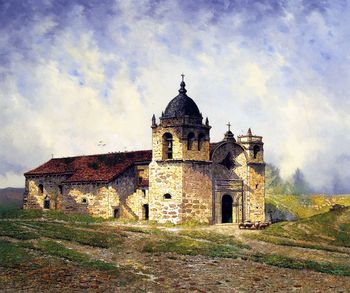Mission San Carlos Borromeo de Carmelo
 Mission San Carlos Borromeo de Carmelo, circa 1899.[1] Mission San Carlos Borromeo de Carmelo, circa 1899.[1]
| |
| HISTORY | |
|---|---|
| Location: | Carmel-by-the-Sea, California |
| Coordinates: | 36° 32′ 34″ N, 121° 55′ 7″ W |
| Name as Founded: | La Misión San Carlos Borromeo del Río Carmelo [2] |
| English Translation: | The Mission of Saint Charles Borromeo, located on the Carmel River |
| Patron Saint: | Saint Charles Borromeo [3] |
| Nickname(s): | "Father of the Alta California Missions" [4] |
| Founding Date: | June 3, 1770 [5] |
| Founded By: | Father Presidente Junípero Serra [6] |
| Founding Order: | Second [3] |
| Headquarters of the Alta California Mission System: | 1771–1815; 1819–1824; 1827–1830 [7] |
| Military District: | Third [8] |
| Native Tribe(s): Spanish Name(s): |
Esselen, Ohlone Costeño |
| Primordial Place Name(s): | Ekheya [9] |
| SPIRITUAL RESULTS | |
| Baptisms: | 3,827 [10] |
| Marriages: | 1,032 [10] |
| Burials: | 2,837 [10] |
| DISPOSITION | |
| Secularized: | 1834 [3] |
| Returned to the Church: | 1859 [3] |
| Caretaker: | Roman Catholic Diocese of Monterey |
| Current Use: | Parish Church |
| National Historic Landmark: | #NPS-66000214 |
| Date added to the NRHP: | October 15, 1966 |
| California Historical Landmark: | #135 |
| Web Site: | http://carmelmission.org |
Mission San Carlos Borromeo de Carmelo is a former religious outpost established by Spanish colonists on the west coast of North America in the present-day State of California. Founded on June 3, 1770 by Roman Catholics of the Franciscan Order in the newly-formed territorial capital at Monterey, the settlement was the second in the twenty-one mission Alta California chain. Named for a 16th century Cardinal Archbishop of Milan, Italy, "Carmel Mission" was the site of the first Christian confirmation in Alta California. On August 1, 1771 (little more than a year after its founding) the Mission was relocated at Father Serra's request to its current location near the present-day town of Carmel-by-the-Sea. When Serra died on August 28, 1784 he was interred beneath Carmel's chapel floor. Designated as both a National Historic Landmark and a California Historical Landmark, the Mission was named as a Minor Basilica by Pope John XXIII in 1961. Today the chapel serves as a parish church within the Roman Catholic Diocese of Monterey.
History
Mission Period (1769 – 1833)
The Esselen and Ohlone Indians who lived near the Mission were taken in and trained as plowmen, shepherds, cattle herders, blacksmiths, and carpenters. They made adobe bricks, roof tiles and tools needed to build the Mission. In the beginning, the Mission relied on bear meat from Mission San Antonio de Padua and supplies brought by ship from Mission San Diego de Alcalá. In 1794, the population reached its peak of 927, but by 1823 the total had dwindled to 381. On November 20, 1818 French privateer Hipólito Bouchard raided the Monterey Presidio, before moving on to other Spanish installations in the south.[11]
Rancho Period (1834 – 1849)
California Statehood (1850 – 1900)
The Mission was in ruins when the Roman Catholic Church regained control in 1863. In 1884 Father Angel Casanova undertook the work of restoration.
20th century and beyond (1901 – present)
In 1931, Monsignor Philip Scher appointed Harry Downie to be curator in charge of Mission restoration; it became an independent parish two years later. Mission Carmel has been designated a National Historic Landmark by the National Park Service. In 1987, Pope John Paul II visited the Mission as part of his U.S. tour. It is also an active parish church of the Roman Catholic Diocese of Monterey.
Notes
- ↑ (PD) Painting: Edwin Deakin
- ↑ Leffingwell, p. 113
- ↑ 3.0 3.1 3.2 3.3 Krell, p. 83
- ↑ Ruscin, p. 25
- ↑ Yenne, p. 33
- ↑ Ruscin, p. 196
- ↑ Yenne, p. 186
- ↑ Forbes, p. 202
- ↑ Ruscin, p. 195
- ↑ 10.0 10.1 10.2 Krell, p. 315: as of December 31, 1832; information adapted from Engelhardt's Missions and Missionaries of California.
- ↑ There is a great contrast between the legacy of Bouchard in Argentina versus his reputation in the United States. In Buenos Aires, Bouchard is honored as a brave patriot, while in California he is most often remembered as a pirate, and not a privateer.